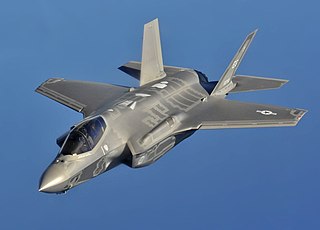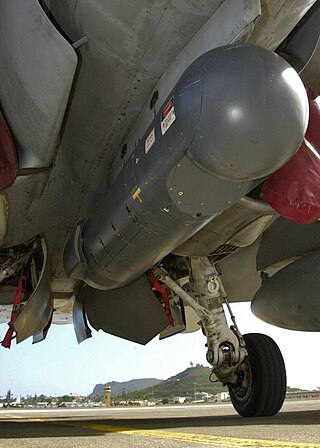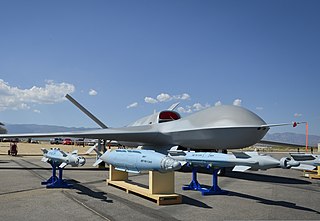Related Research Articles

The Lockheed Martin F-35 Lightning II is an American family of single-seat, single-engine, all-weather stealth multirole combat aircraft that is intended to perform both air superiority and strike missions. It is also able to provide electronic warfare and intelligence, surveillance, and reconnaissance capabilities. Lockheed Martin is the prime F-35 contractor, with principal partners Northrop Grumman and BAE Systems. The aircraft has three main variants: the conventional takeoff and landing (CTOL) F-35A, the short take-off and vertical-landing (STOVL) F-35B, and the carrier-based (CV/CATOBAR) F-35C.

The Lockheed Martin F-22 Raptor is an American single-seat, twin-engine, all-weather stealth tactical fighter aircraft developed for the United States Air Force (USAF). As the result of the USAF's Advanced Tactical Fighter (ATF) program, the aircraft was designed as an air superiority fighter, but also has ground attack, electronic warfare, and signals intelligence capabilities. The prime contractor, Lockheed Martin, built most of the F-22's airframe and weapons systems and conducted final assembly, while Boeing provided the wings, aft fuselage, avionics integration, and training systems.

The fourth-generation fighter is a class of jet fighters in service from around 1980 to the present, and represents design concepts of the 1970s. Fourth-generation designs are heavily influenced by lessons learned from the previous generation of combat aircraft. Third-generation fighters were often designed primarily as interceptors, being built around speed and air-to-air missiles. While exceptionally fast in a straight line, many third-generation fighters severely lacked in manoeuvrability, as doctrine held that traditional dogfighting would be impossible at supersonic speeds. In practice, air-to-air missiles of the time, despite being responsible for the vast majority of air-to-air victories, were relatively unreliable, and combat would quickly become subsonic and close-range. This would leave third-generation fighters vulnerable and ill-equipped, renewing an interest in manoeuvrability for the fourth generation of fighters. Meanwhile, the growing costs of military aircraft in general and the demonstrated success of aircraft such as the F-4 Phantom II gave rise to the popularity of multirole combat aircraft in parallel with the advances marking the so-called fourth generation.

The McDonnell Douglas CF-18 Hornet is a Royal Canadian Air Force (RCAF) variant of the American McDonnell Douglas F/A-18 Hornet fighter aircraft. In 1980, the F/A-18 was selected as the winner of the New Fighter Aircraft Project competition and awarded a production order; deliveries of the CF-18 to the Canadian Armed Forces began in 1982. CF-18s have supported North American Aerospace Defense Command (NORAD) air sovereignty patrols and participated in combat during the Gulf War in 1991, the Kosovo War in the late 1990s, and as part of the Canadian contribution to the international Libyan no-fly zone in 2011. CF-18s were also part of the Canadian contribution to the military intervention against ISIL, Operation Impact.

Stealth aircraft are designed to avoid detection using a variety of technologies that reduce reflection/emission of radar, infrared, visible light, radio frequency (RF) spectrum, and audio, collectively known as stealth technology. The F-117 Nighthawk was the first operational aircraft specifically designed around stealth technology. Other examples of stealth aircraft include the B-2 Spirit, the B-21 Raider, the F-22 Raptor, the F-35 Lightning II, the Chengdu J-20, and the Sukhoi Su-57.

The McDonnell DouglasF-15E Strike Eagle is an American all-weather multirole strike fighter derived from the McDonnell Douglas F-15 Eagle. The F-15E was designed in the 1980s for long-range, high-speed interdiction without relying on escort or electronic-warfare aircraft. United States Air Force (USAF) F-15E Strike Eagles can be generally distinguished from other US Eagle variants by darker aircraft camouflage, conformal fuel tanks (CFTs) mounted along the engine intake ramps and a tandem-seat cockpit.

The Boeing F/A-18E and F/A-18F Super Hornet are twin-engine, carrier-capable, multirole fighter aircraft variants derived from the McDonnell Douglas F/A-18 Hornet series. The F/A-18E single-seat and F/A-18F tandem-seat variants are larger and more advanced versions of the F/A-18C and D Hornet.

The AN/AAQ-28(V) Litening targeting pod is an advanced precision targeting pod system currently operational with a wide variety of aircraft worldwide. The research and development of the Litening was first undertaken by Rafael Advanced Defense Systems' Missiles Division in Israel, with subsequent completion of Litening I for use in the Israeli Air Force.

The Air Force Test Center (AFTC) is a development and test organization of the United States Air Force. It conducts research, development, test, and evaluation of aerospace systems from concept to deployment. It has test flown every aircraft in the Army Air Force's and the Air Force's inventory since World War II. The center employs nearly 13,000 people, and controls the second largest base in the Air Force.
Bill Sweetman is a former editor for Jane's and currently an editor for Aviation Week group. He is a writer of more than 50 books on military aircraft. He lives in Oakdale, Minnesota. He is noted for his dogged pursuit of the Aurora project. He appeared as an Aerospace Consultant on in the Nova PBS TV program "Battle of the X-Planes" about the Joint Strike Fighter Program.
The planning for the future of the Royal Air Force involves supporting ongoing British military operations, the introduction of new aircraft types including unmanned aerial vehicles, greater focus on network enabled capability and increasing interoperability with members of NATO, team tempest, and mixed crewed fighters. From the updated plans of the RAF (2021) state that the new initiative will focus on becoming carbon net-zero, with strategies such as using sustainable aviation fuels in aircraft. The RAF also are looking into investing in the maintenance of the aircraft to ensure success of future operations.

A fifth-generation fighter is a jet fighter aircraft classification which includes major technologies developed during the first part of the 21st century. As of 2023, these are the most advanced fighters in operation. The characteristics of a fifth-generation fighter are not universally agreed upon and not every fifth-generation type necessarily has them all; however, they typically include stealth, low-probability-of-intercept radar (LPIR), agile airframes with supercruise performance, advanced avionics features, and highly integrated computer systems capable of networking with other elements within the battlespace for situation awareness and C3 (command, control and communications) capabilities.

The General Atomics MQ-20 Avenger is a developmental unmanned combat aerial vehicle built by General Atomics Aeronautical Systems for the U.S. military.
A sixth-generation fighter is a conceptualized class of jet fighter aircraft design more advanced than the fifth-generation jet fighters that are currently in service and development. Several countries have announced the development of a sixth-generation aircraft program, including the United States, Russia and China, while Japan, Italy, the United Kingdom, France, Germany, Spain, and Sweden have joined together in collaborative multinational programs in an effort to spread development costs. The first sixth-generation fighters are expected to enter service in the 2030s.
F/A-XX is a development and acquisition program for a future sixth-generation air superiority fighter to replace the United States Navy's F/A-18E/F Super Hornet and complement the F-35C beginning in the 2030s. A requirement was first identified in June 2008.

The Chengdu J-20, also known as Mighty Dragon, is a twinjet all-weather stealth fighter aircraft developed by China's Chengdu Aerospace Corporation for the People's Liberation Army Air Force (PLAAF). The J-20 is designed as an air superiority fighter with precision strike capability. The aircraft has three variants: the initial production model J-20A, the thrust-vectoring J-20B, and twin-seat aircraft teaming capable J-20S.

The Unmanned Carrier-Launched Airborne Surveillance and Strike (UCLASS) was a United States Navy program to develop an autonomous carrier-based unmanned combat aerial vehicle providing an unmanned intelligence and strike asset to the fleet. After debate over whether the UCLASS should primarily focus on stealthy bombing or scouting, the Pentagon instead changed the program entirely into the Carrier-Based Aerial-Refueling System (CBARS) to create a UAV for aerial refueling duties to extend the range of manned fighters, which lead to the Boeing MQ-25 Stingray.
Cooperative Engagement Capability (CEC) is a sensor network with integrated fire control capability that is intended to significantly improve battle force air and missile defense capabilities by combining data from multiple battle force air search sensors on CEC-equipped units into a single, real-time, composite track picture. This will greatly enhance fleet air defense by making jamming more difficult and allocating defensive missiles on a battle group basis.

Lockheed Martin F-35 Lightning II development started in 1995 with the origins of the Joint Strike Fighter program and culminated in the completion of operational testing and start of full-rate production in 2021. The X-35 first flew on 24 October 2000 and the F-35A on 15 December 2006.
The Future Offensive Air System was a study to replace the Royal Air Force's strike capability, at the time provided by the Tornado GR4. Initial operational capability was expected around 2017. The FOAS was cancelled in June 2005 and was replaced by the Deep and Persistent Offensive Capability (DPOC) requirement, which was itself cancelled in the 2010 Strategic Defence and Security Review.
References
- ↑ Modelling radio propagation and contention in emulated defence networks, MilCIS, 8–10 November 2011, by M. Britton and A. Coyle.
- ↑ Harris Multifunction Advanced Data Link (MADL) Archived 2009-06-26 at the Wayback Machine
- ↑ "Israel, U.S. Agree To $450 Million In F-35 EW Work." Av Week, 6 August 2012.
- ↑ " "F-35 Flight Test Update 11 | Code One Magazine".
- ↑ http://www.airforcetimes.com/news/2011/03/air-force-raptor-madl-upgrade-033111w/ [ dead link ]
- ↑ LaGrone, Sam (13 September 2016). "Successful F-35, SM-6 Live Fire Test Points to Expansion in Networked Naval Warfare". news.usni.org. USNI News. Retrieved 24 November 2016.
- ↑ Seligman, Lara (24 November 2016). "How F-35 Is Transforming U.S. Marine Corps Strike Operations". aviationweek.com. Penton. Retrieved 24 November 2016.